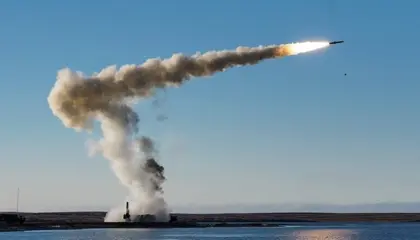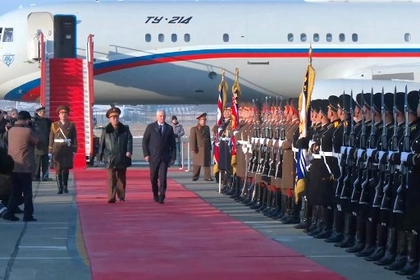Russian Federation (RF) air, naval and ground forces on Friday launched a renewed series of long-range missile strikes against Ukraine’s power grid and civilian infrastructure, causing damage across the country. Thus far, no death have been reported and according to multiple reliable sources NATO air space was violated for the first time by a Russian cruise missile.
Ukrainian defense officials reported ten Russian air force bombers flying in airspace over southwest Russia, and at least one guided missile frigate cruising near the Crimea peninsula in the Black Sea, fired air-launched X-101 and sea-launched Kinzhal cruise missiles in the morning strikes. At least 40 cruise missiles were fired in two waves from multiple directions, air defense officials said.
Russian ground forces fired a reported 30 to 35 shorter-range S-300 anti-aircraft missiles to attack Ukraine’s second-largest city Kharkiv from Russia’s Belgorod Oblast to the north and the industrial city Zaporizhzhia from launch sites in southern Ukrainian territory occupied by Russian forces.
Eight people in Kharkiv were injured from blasts in and around the city, and two were in serious condition, local officials said.
The Kremlin in October began a campaign to force Kyiv to accept Russia’s invasion and capture of Ukraine’s southern and eastern regions, and disarm the Ukrainian military by launching waves of cruise missiles and kamikaze drones at Ukrainian civilian homes, businesses and power grid infrastructure. On average, Russian forces have launched between one and two hundred weapons a month.

Luxury Western Goods Line Russian Stores, Three Years Into Sanctions
For the first time since that bombardment campaign began, a Russian cruise missile violated NATO air space, multiple reliable sources said.
Valery Zaluzhny, Ukraine armed forces commander, in a late morning statement, said two Russian naval-launched Kaliber missiles flew into Moldovan air space and then into Romania air space before exiting and heading north toward targets in west Ukraine. Romania is a NATO member.
Multiple reliable sources generally substantiated Zaluzhny’s statement. Vitaly Kim, head of the southern Mykolaiv regional defense command, said local air defenses engaged missiles attacking from the south and the Black Sea, and that at least one weapon passed through Ukrainian air space and entered Moldovan air space.
Ukrainian Anatoly Tsiaplenko, citing Ukrainian military sources, and 90 minutes before Zaluzhny’s statement, said a Russian missile entered and exited the air space of Romania before flying on into western Ukraine. Moldova’s Defense Ministry confirmed in a statement that at least one missile had been sighted flying in Moldovan air space, in two locations.
Moldovan air defense units were able to fire on the missiles but the national defense command in Chisinau ordered them not to engage, to protect “neighboring states” from falling debris, the statement said.
Over the course of 2022, NATO, led by the US Air Force, has reportedly concentrated a powerful strike force of 150 to 200 combat jets and air war support units at air bases in eastern Romania and Poland, following Russia’s massive invasion of Ukraine on Feb. 24. It was not clear what action, if any, these forces took to respond to the two Kinzhal missiles that reportedly flew into and out of Romanian air space.
Russian Tu-95 strategic bombers initiated missile drops at 9:20 a.m., Ukrainian military spokesmen said. As has become almost routine across Ukraine during Russian missile attacks, millions of civilians nationwide were glued to their smart phones as civilian and official information platforms tracked the explosive-tipped missiles’ flight paths across the country, and waited for news of Ukrainian air defenses engaging the incoming weapons.
In the capital several Kyiv Post reporters heard air explosions, a high-speed autocannon firing, and the sound of a cruise missile or combat aircraft flying overhead. This was followed by a powerful explosion at 10:05. It was not clear if the blast was a missile shot down by Ukrainian air defense forces, or a successful Russian ground strike.
Along with dozens of cruise missiles launched at Ukraine over the morning, Russian ground personnel fired Iranian Shahed drones, a less powerful but more elusive weapon, from occupied Ukrainian territory as well. Russian strike planners in the past have launched the small drones ahead of cruise missiles as a distraction tactic against Ukrainian air defenses.
Kremlin-controlled information platforms showed images of fires or black smoke rising from what they claimed were power generation sites in at least six Ukrainian cities, including Kyiv, which had been hit by Russian missiles.
Air explosions were reported in the sky above the eastern city of Dnipro in the early morning hours, at 4:30 a.m. Minutes later, an announcement from the Kyiv city administration informed residents that Ukrainian air force combat jets were in action above the capital.
By mid-morning local authorities reported falling missile debris had landed in Kyiv’s southern Holosiyivsky district. The debris smashed the roof of a house, damaged a car and cut local power lines, the UNIAN news agency reported.
In the central city of Khmelnytsky news platforms reported that a kamikaze drone hit a power grid site. Social media images showed a fire burning and thick black smoke against a mostly clear dawn sky. Ground explosions following probable cruise missile strikes were reported in Kyiv, Odesa, in the central cities of Kropyvnytsky and Dnipro.
In Kharkiv, near the Russian border, officials reported multiple hits, and in Zaporizhzhia mayor Anatoly Kurtev said at least 17 missiles detonated. According to early reports, Russian planners used shorter-range S-300 missiles for the strikes.
Serhiy Lysak, head of the southern Kryvy Rih regional defense command, said in a statement later in the morning that air defense units shot down “all the Iranian drones” but at least one cruise missile had struck power grid infrastructure, causing serious damage. Falling debris from an intercepted cruise missile hit a two-story private home, smashing the roof but causing no injuries, he said.
Early reports from local air defense commands reported, as in past strikes, around three quarters of the incoming missiles failed to hit targets and were shot down. The Armed Forces of Ukraine (AFU) official kill claim data was still being compiled by midday. A statement from Ukraine’s Main Directorate of Military Intelligence claimed practically all incoming missiles were intercepted: “The Russian missile blitzkrieg failed miserably.”
The missile launches triggered air raid warnings across Ukraine and snarled morning commuter traffic in some city centers. The Kyiv city metro, as in past strikes, continued operations but train cars were jammed to overloading as commuters switched from private cars to public transport to get to work.
Power grid operators in some cities, including the capital Kyiv, blacked out regions in the missiles’ path, to forestall grid overloads in case of a successful ground strike.
A statement from the national power operator Ukrenergo said: “There have been strikes in some parts of the high power transmission infrastructure in eastern, western and southern regions, which has caused some interruptions in electricity delivery, at some locations.”
Oleh Synyehubov, head of the Kharkiv regional defense command, said that about 150,000 city residents were without power. Power outages also were reported in Khmelnytsky,
The national railroad company Ukrzaliznytsia reported 5 of 65 trains moving as the strikes came in would be at least five minutes late, and of those three might be delayed up to a half hour.
Air defense authorities called an all clear and cancelled air raid alerts at midday. Then, a little more than hour later, another alert informed Ukrainians that three planes – potentially carrying Kinzhal missiles – were in the air.
You can also highlight the text and press Ctrl + Enter






